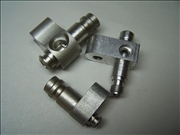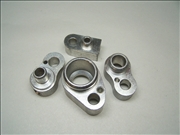Precision Machining.
Process
Conventional machining, one of the most important material removal methods, is a collection of material-working processes in which power-driven machine tools, such as lathes, milling machines, and drill presses, are used with a sharp cutting tool to mechanically cut the material to achieve the desired geometry. Machining is a part of the manufacture of almost all metal products, and it is common for other materials, such as wood and plastic, to be machined.
Types of machining operation
There are many kinds of machining operations, each of which is capable of generating a certain part geometry and surface texture.
In turning, a cutting tool with a single cutting edge is used to remove material from a rotating workpiece to generate a cylindrical shape. The speed motion in turning is provided by the rotating workpart, and the feed motion is achieved by the cutting tool moving slowly in a direction parallel to the axis of rotation of the workpiece.
Drilling is used to create a round hole. It is accomplished by a rotating tool that is typically has two cutting edges. The tool is fed in a direction parallel to its axis of rotation into the workpart to form the round hole.
In boring, the tool is used to enlarge an already available hole. It is a fine finishing operation used in the final stages of product manufacture.


In milling, a rotating tool with multiple cutting edges is moved slowly relative to the material to generate a plane or straight surface. The direction of the feed motion is perpendicular to the tool's axis of rotation. The speed motion is provided by the rotating milling cutter. The two basic forms of milling are peripheral milling and face milling.
Other conventional machining operations include shaping, planing, broaching and sawing. Also, grinding and similar abrasive operations are often included within the category of machining.